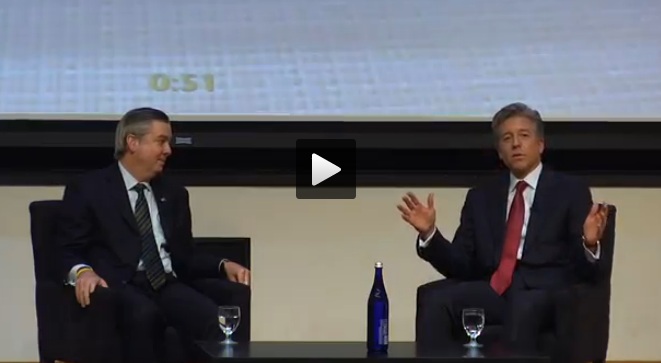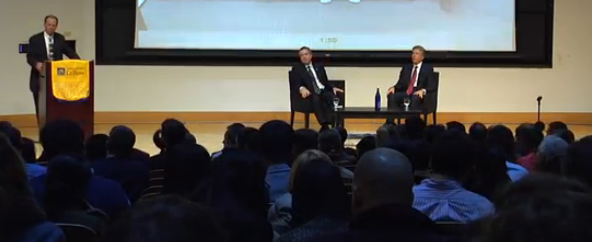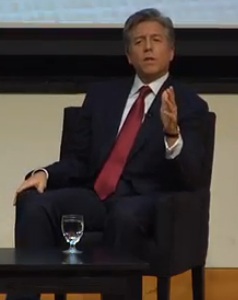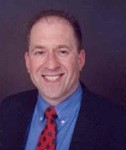The blog below and video was originally posted on the SAP Community Network after a November 2012 Fireside Chat with Bill McDermott, co-CEO of SAP and President John Fry at Drexel.
—
View from the Top: Bill McDermott shares his success secrets at a #fireside chat!

“In the end, it’s the customer and the customer alone that determines if we have a job
“You need to constantly be innovating for the future, while you’re executing for the present
…the best leaders understand that!”
“You all can make a difference, the young generation coming out of the universities and coming into the workforce. You see things we don’t see, your ideas are unique, you understand where the world is going, you understand social. You get all that, and I think that’s such an unbelievable opportunity to help the economy, create innovation, create jobs, and push things forward.”
—Quotes from Bill McDermott, co-CEO of SAP AG
~~~~~~~~~~~~~~~~~~~~~~~
Learning from Top Leaders
~~~~~~~~~~~~~~~~~~~~~~~
The “View from the Top” Fireside Chat with Bill McDermott, co-CEO of SAP and Drexel University’s President John Fry on November 1 was an amazing opportunity to learn from two top leaders who have a lot in common with each other. Both are visionaries who provide transformational leadership to large organizations and most importantly they both value helping the community.
The topics included themes such as jobs, trends, and leadership which are of interest to students, alumni, professors, and professionals both in the audience and around the globe far beyond the “375” who attended in Philadelphia, Pennsylvania and Sacramento, California (USA) (via a live video feed) along with 30-40 who were turned away due to the auditorium’s capacity!
~~~~~~~~~~~~~~~~~~~~~~~~~~~~~~~~~~~~~
A Students Reflection – Now and Years Later
~~~~~~~~~~~~~~~~~~~~~~~~~~~~~~~~~~~~~
Everyone who attended benefited including:
- Students who are looking for their job upon graduation
- Alumni who are successful and want to take their career to the next level
- Professors and lecturers who teach SAP-related courses and/or want to position their students for a competitive marketplace
- Recent graduates who have their first job and want to navigate to achieve success within their organization and with customers
- Employees and professionals who want to learn about the recipes for success!
The bottom-line is that in my case, I can remember… a time when I was a student (back in the day!)… when I was (& still am) hungry to receive wisdom, knowledge and lessons learned from top executives, leaders, and experts. Often it can be hard to come by. The opportunity to learn from these leaders was an amazing opportunity!
the day!)… when I was (& still am) hungry to receive wisdom, knowledge and lessons learned from top executives, leaders, and experts. Often it can be hard to come by. The opportunity to learn from these leaders was an amazing opportunity!
~~~~~~~~~~~~~~~~~~~~~~~~
So What are the Takeaways?
~~~~~~~~~~~~~~~~~~~~~~~~
All of us are on a journey! From our early school days to now we are all the product of our decisions. Learning from top leaders can provide us insights on how to be successful. We can learn… What worked for them? How can we apply it to our own situations? What big or small idea can help us to save time and accelerate our careers and ultimately win!?
The topics shared included:
- Jobs – Competing to jumpstart your career
- Trends – Identifying global opportunities in the marketplace including China and beyond
- Leadership – Sharing lessons learned and best practices
But there’s an even a greater reason why this event was memorable and worth watching on the video… and that’s the stories…
 Bill McDermott provided masterful insights by telling us everyday stories that he experienced from his first business owning a deli (and a few video games!) at age 17 to his first job upon graduation at Xerox and how he conducted his business as a Xerox “Marketing Representative” on the streets of New York City selling door-to-door. While he did share insights on SAP including the value of the SAP University Alliances Program which were phenominal, a lot of his discussion was down-to-earth vignettes which we can all relate to in our everyday work, lives, and plans for the future.
Bill McDermott provided masterful insights by telling us everyday stories that he experienced from his first business owning a deli (and a few video games!) at age 17 to his first job upon graduation at Xerox and how he conducted his business as a Xerox “Marketing Representative” on the streets of New York City selling door-to-door. While he did share insights on SAP including the value of the SAP University Alliances Program which were phenominal, a lot of his discussion was down-to-earth vignettes which we can all relate to in our everyday work, lives, and plans for the future.
 President John Fry did a wonderful job of providing his insights including a very strategic Innovation Neighborhood planned as the gateway from 30th Street (a top East Coast transportation hub in the United States) to Drexel’s campus in West Philadelphia (& University City).
President John Fry did a wonderful job of providing his insights including a very strategic Innovation Neighborhood planned as the gateway from 30th Street (a top East Coast transportation hub in the United States) to Drexel’s campus in West Philadelphia (& University City).
In addition, he ensured that the flow of the Fireside Chat provided the maximum value for the audience..
.
~~~~~~~~
Summary
~~~~~~~~
The knowledge shared will help and inspire students, alumni, professors/lecturers, and professionals from around the globe who are the “current” and “future” business and IT leaders!
The opportunity to have a front row seat, to hear the video, and review the recap on the Business Innovation site will provide inspiration to all who take the time to learn more!
In my case, having watched this event live from the front row; I can truly say that listening to the video the second time around is even more inspirational: I’m looking forward to sharing it with my team as well as hearing it a few more times!
.














